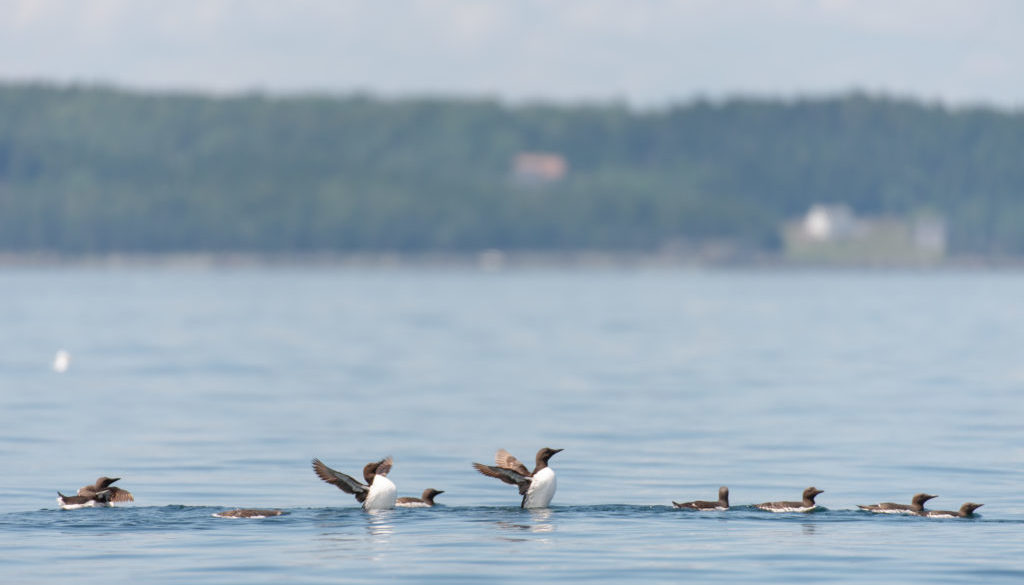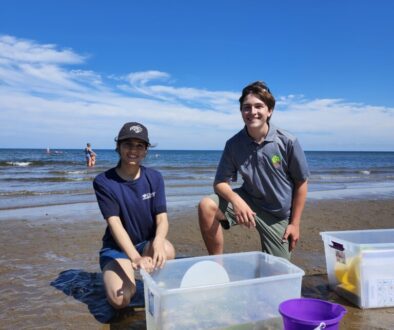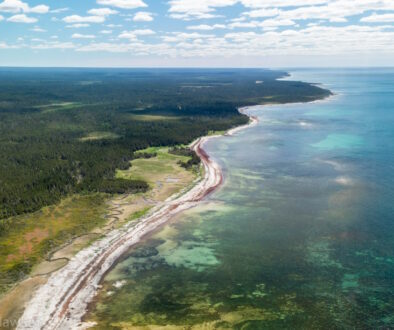10 Underrated species of the Bay of Fundy

When I think of the Bay of Fundy, a few things come to mind: a salty breeze, tangled hair, and the blow of a whale. For most of us, when we think of Fundy wildlife, we are quick to list the whales, the seals, the sharks, and maybe a few of the more delicious fish and shellfish, but the Bay is bursting with a huge diversity of species that rarely see the spotlight. While there are many more than just ten species that deserve their 15 seconds of fame, join me as I highlight a few of Fundy’s unsung heroes.
1. Sea potato – It seems only fitting that in a potato-growing province like New Brunswick, we would have both land and sea potatoes. Of course, the sea potato is a very different creature! The sea potato is a type of urchin that, when dried, looks like a peeled potato. Sea potatoes live at the bottom of the Bay in vibrant ecosystems with other urchins, sea stars, crabs, and corals. They like to bury themselves in the sand and will filter tiny food from the flowing water. Sometimes this species is called the heart urchin, but I prefer sea potato given our province’s history with agriculture.

2. Winter flounder – Okay, as a commercial fish species you might not think the flounder is underrated, but let’s just talk about how neat this fish is. Flounder are born like most other fish, with eyes on either side of their head, but as they age their left eye will migrate the join the right! This is how flounder are successful predators from the sea floor, they lie at the bottom with both eyes facing up until prey approaches, which might be a small or young fish, shrimp, ocean worms, or even clams. The winter flounder can also tolerate a wide range of salty environments, making it well suited to the sometimes less salty areas of the Bay where rivers meet the ocean.
3. Winged kelp – Kelp is amazing. Sea kelps can be among the fastest growing organisms on the planet! Kelp are primary producers, turning the sun’s energy into the base of the food web and producing the oxygen we breathe. Winged kelp, like other kelp species, have many benefits for us humans! Extracts from winged kelp can protect our youthful skin and has been used in beauty care products. More recently, extracts from winged kelp have been studied by scientists as a potential treatment for Parkinson’s disease1.
4. Horse mussels – The less popular mussel of the Bay of Fundy since it is not often served with garlic butter, the horse mussel is an important species for creating habitat in the Bay. As sand and mud move across the seafloor with the tides, this sediment gets caught in the threads that attach mussels to hard surfaces. Once old mussels die and muddy sediment builds up around mussels, a reef grows! These horse mussel reefs provide habitat for other bottom-dwelling species, creating refuge from predators and protecting species from the strong Fundy tides. In fact, the Bay of Fundy is home to the world’s largest known horse mussel reef!
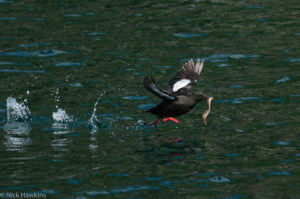
5. Black guillemot – A deep black bird with bright white wing patches, and vivid red feet, the black guillemot is a relative of the puffin and is abundant around the Bay. We are fortunate to witness many migrating birds in the region, but this more common and sometimes less exciting bird is a beauty! The black guillemot is a diving bird, eating small fish, shrimps, and other invertebrates. A funny little bird, some black guillemots show a preference for which direction the head of a fish points when held in its bill!
6. Atlantic herring – While it is admittedly not the most exciting fish in the Bay of Fundy, the Atlantic herring is an extremely important species to the vibrant ecosystem we know and love. As the water warms and the krill bloom, herring too become abundant in the Bay and attract the famous whales, seabirds, and sharks to Fundy for their annual fish feed. Atlantic herring aren’t only an ecologically important species in the Bay, but they have formed our maritime culture in many ways from weir to cannery.
7. Spiny dogfish shark – Great whites, porbeagles, basking, and other big sharks frequent the Fundy waters, but have you heard of this little shark? The spiny dogfish shark grows to be about one meter long and has a reputation for relentlessly stalking its prey. This is a schooling shark, forming groups of hundreds or even thousands of individuals! It is also a commercially important species and has historically been fished for the oil in its liver that was used in lamps and for machine lubricants.
8. Acadian hermit crab – A classic touch-tank species, the hermit crab is arguably the Bay of Fundy’s cutest crustacean. As the crab grows, it must exchange its shell for one of greater size, meaning that unlike other crustaceans it doesn’t grow its own shell! Instead, its abdomen is soft and looks a bit like a cooked lobster tail. Despite their names, hermit crabs do best when surrounded by other crabs. This crab likes to live in large colonies, sometimes of more than 100 individuals!
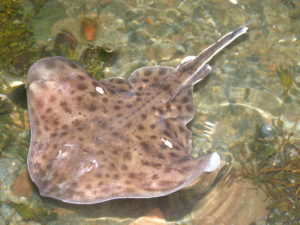
9. Winter skate – No, I don’t mean ice skates. A skate is a relative of sharks and rays, having a diamond-shaped body like stingrays, but a thicker tail and no sting, though this skate does have small thorns on its body. The winter skate tends to live on or near the seafloor, growing to be 1.5 meters in length and living for about 20 years! The winter skate is listed as “threatened” by the Committee on the Status of Endangered Wildlife in Canada (COSEWIC), which resulted in the closure of a small directed fishery for this species.
10. Northern Shortfin Squid – The Northern shortfin squid is among the many seasonal visitors to the Bay of Fundy, being a highly migratory species in the Atlantic Ocean. Like other squid and squid-relatives, this species avoids predation using camouflage, ink release, jet propelled water to escape, and by living in large schools of squid. These squid lay long, jelly-like balloons of 10 to 100 thousand eggs, but individuals live for less than a year! If you’re lucky, you might see these egg balloons along the Bay of Fundy coast.
While I’ve highlighted only a few underrated species in this list, remember that the Bay of Fundy is home to more than 2000 species of plants and animals! While these species have different conservation status’, meaning that some are common and others are at risk, each has an important role in the ecosystem and is threatened by an unprotected Bay of Fundy.
A network of marine protected areas in the Bay of Fundy would increase the likelihood that each of these species is captured at some life stage in a protected area where human impacts are reduced. Marine protected areas need to strategically target both species that are in the greatest need of protection and the abundant species that support a healthy ecosystem. That’s why CPAWS-NB is working hard to see the establishment of a network of protected areas in the Bay of Fundy, and we need your help! Add your voice to our campaign for this network by visiting http://www.protectbayoffundy.ca.
Header photo by Justin Dutcher, Dutch Elms Studios
References:
Giffin, J.C., Richards, R.C., Craft, C., Jahan, N., Leggiadro, C., . . . & Ewart, K.V. (2017). An extra of the marine alga Alaria esculenta modulates a-synuclein folding and amyloid formation. Neuroscience Letters, 644, 87-93.

